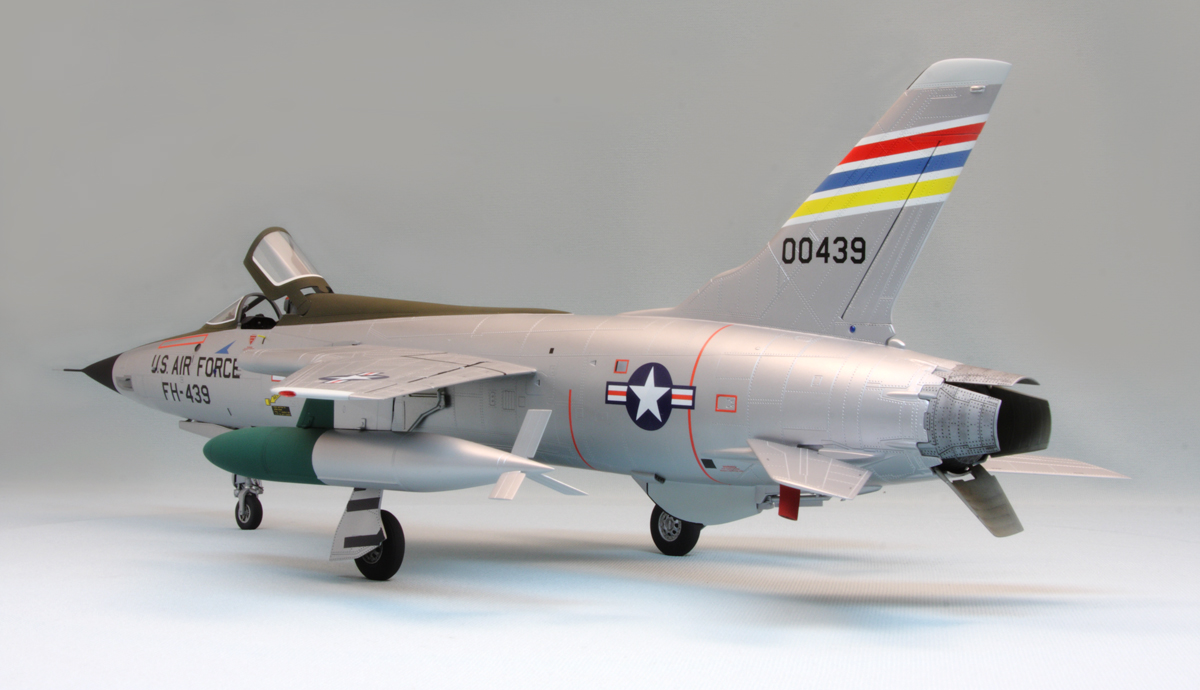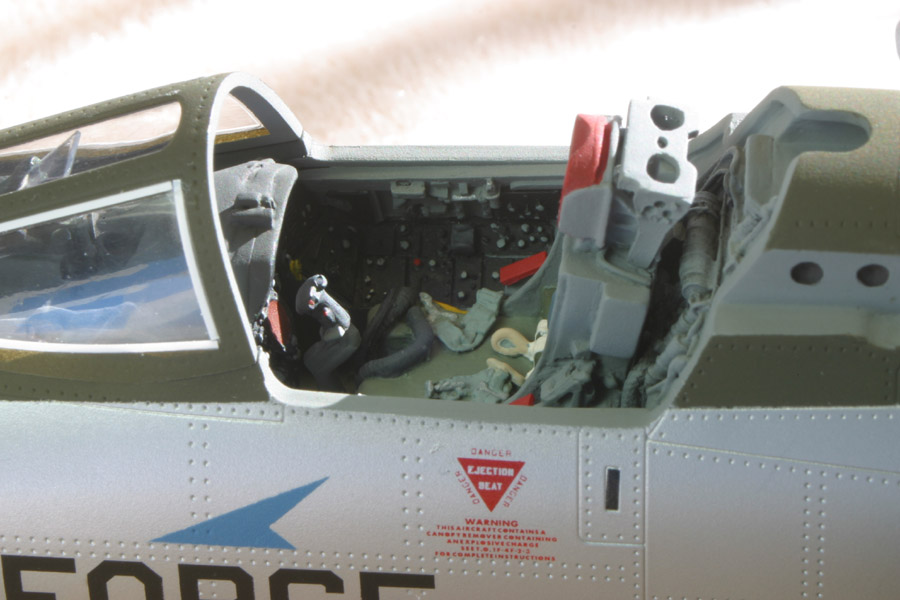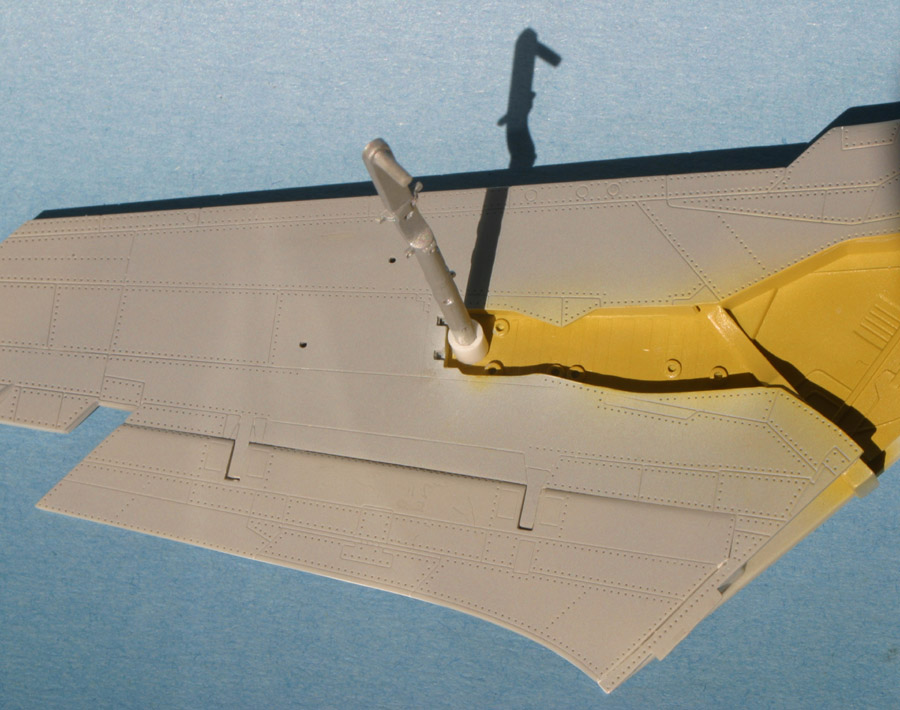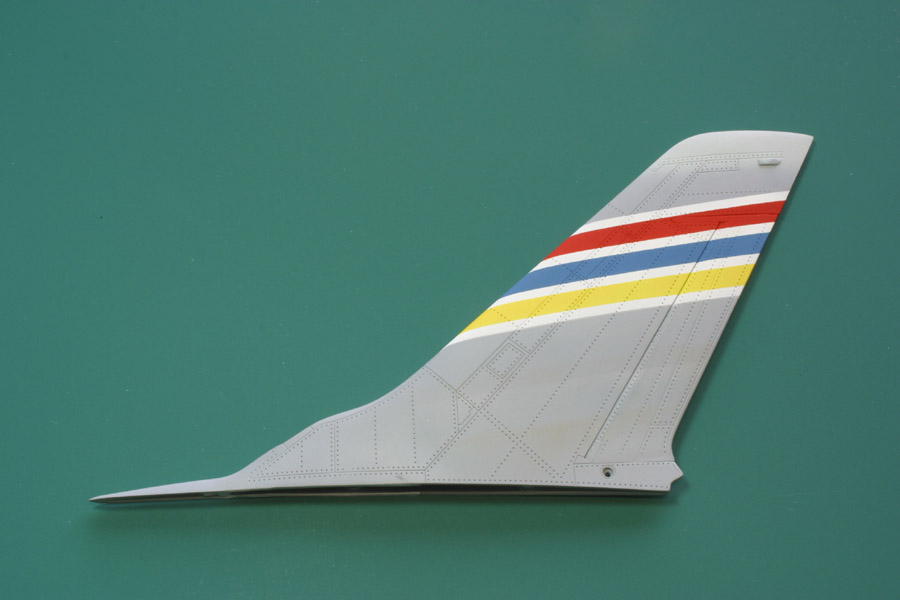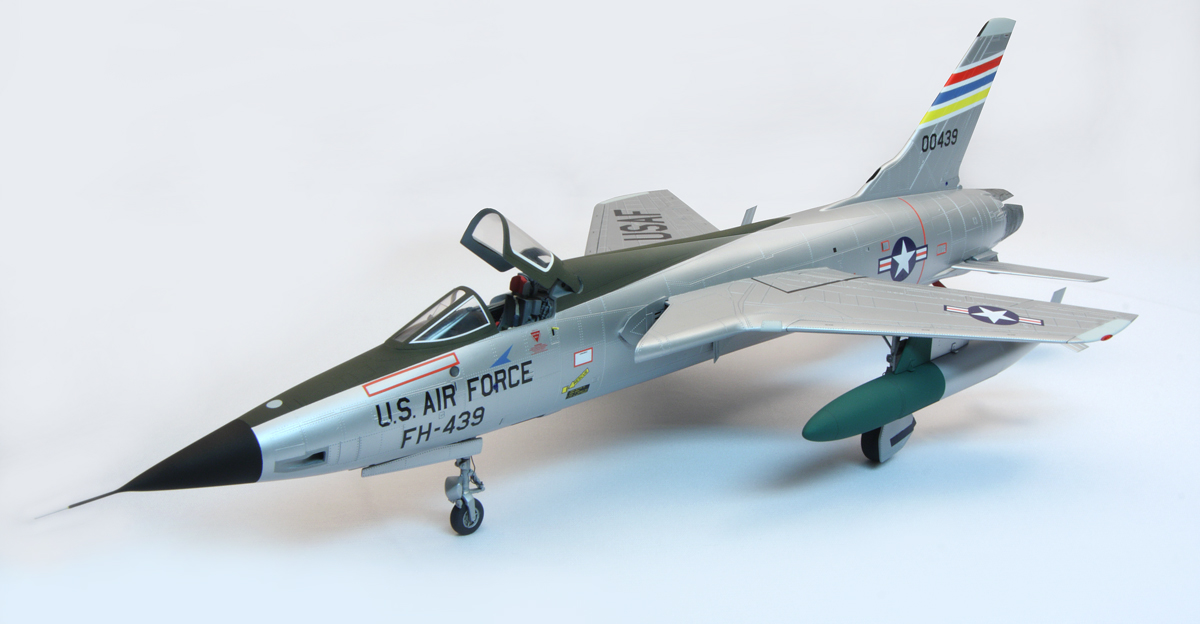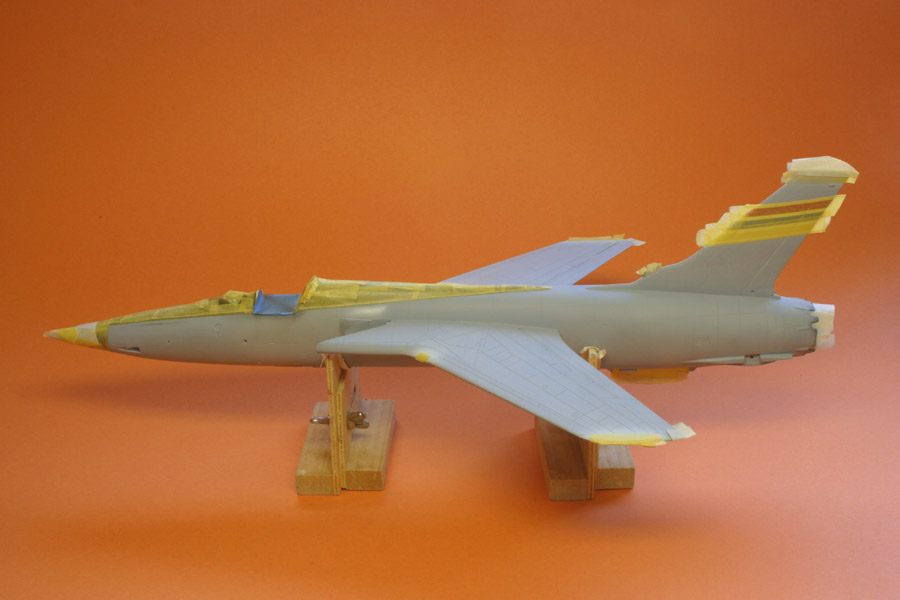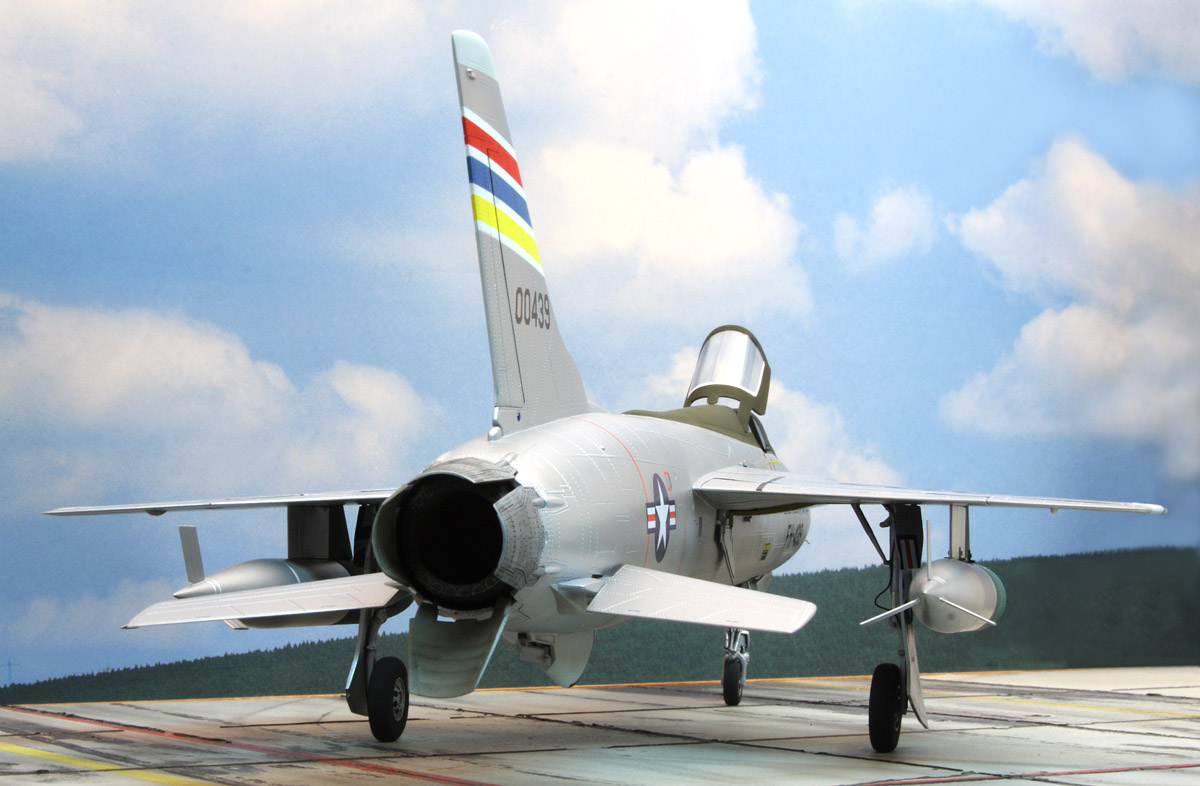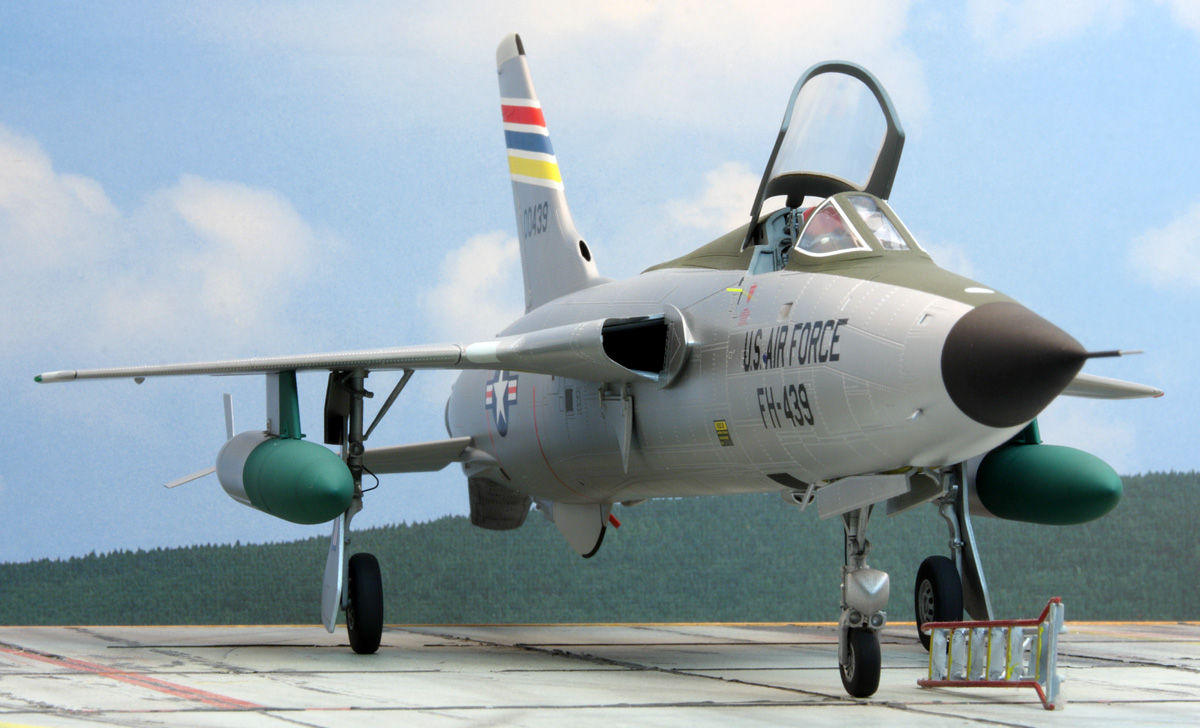Introduction
For the history of the subject and my first look, in-box review, see the October 2008 Internet Modeler. To recap, the Hobby Boss (HB) kit is essentially a smaller and simpler version of the Trumpeter 1/32 scale F-105D.
My Thunderchief
My Chief is a member of the 36th Tactical Fighter Wing at Bitburg AB, Germany in 1965. The diagonal color bands on the tail represent the three squadrons assigned to the wing. The jets were painted with a silver lacquer finish to protect against moisture and corrosion. It was common practice to paint olive drab or dark green anti-glare panels on the upper portion of the drop tanks. Sometimes the entire tank was painted all the way back into the pylon, as on my aircraft.Construction Issues
The most fundamental problem with this kit is that it is over-engineered. There are too many features (open gun bay, open radar, open refueling probe bay, engine & separate rear fuselage, separate control surfaces-- including the extreme step of molding separate spoilers, etc.). If you are the type of modeler who likes everything hanging out, then this HB kit is made for you. Go ahead, display your toy-like engine. I, however, prefer a realistic flightline presentation of a closed-up jet.
In general, the fit was mediocre at best. Among other things, I had difficulty placing the wing control surfaces in the neutral position, and there were unsightly gaps between the ailerons and flaps. My remedy was to insert sheet styrene. The rudder did not match-up properly with the tail trailing edge, and again there was more styrene, putty, and sanding required. Of course, the equipment bay covers and the radome did not fit well, either. Primer paint revealed several small sink marks to deal with on the wings and the rear fuselage.The intake splitter plates (parts F-47 and F-48) did not line up properly, so I cut off the mounting pins for better positioning.
The landing gear presented problems. The holes in the main wheels were too large for the strut axles, so I inserted tiny strips of styrene to accomplish a snug fit. The instructions would have the builder assemble the entire nose gear unit and then build up the wheel well walls around it, all before placement inside the fuselage. This is impractical. I installed only the upper undercarriage parts in the well (parts F1 and F-26) after pre-painting the well. I left off the rest of the nose gear until much later in the construction process.The main gear legs are very long and skinny, just as on the real aircraft. This unfortunately makes the model wobble, but my main concern was beefing- up the attachment point in the wheel well, which I accomplished by installing a collar made from plastic tubing. I didn't bother with metal gear (which is only available for the Monogram F-105) because it would also have a problematic attachment even if it fit the HB kit.
The drop tanks were another hassle, since the panel lines did not match up well on left and right halves.
Conversion
This project demanded a lot of work to backdate the kit into an early F-105D. The largest and most difficult task was to remove the rear portion of the dorsal spine and reshape the tip as well making a new forward piece for the vertical tail(I also enlarged the intake in the leading edge of the tail). Appropriate shapes from my spares box were helpful here. The resulting spine is not totally accurate, but I'm satisfied with it.Other conversion steps included:
1) removing the strike camera/ECM fairing from the lower nose
2) removing the ECM antennae from the top of the tail fin
3) removing the dorsal beacon light housing from the spine
4) filling the gun gas vents on part F-13
5) filling six pairs of tiny rear fuselage vents
6) omitting the rear fuselage afterburner cooling scoops (parts B11 and C-13) and removing the underlying raised plates
7) removing the raised reinforcement plates from the wing lower surfaces
8) creating (with decals) a new square vent in the rear fuselage near the national insignia on both sides
Inaccuracies
As I built the model, I discovered several inaccuracies. I won't go into the weeds here to discuss the small ones, but I will point out three glaring errors that should be corrected by any serious modeler.First, the entire cockpit sits too high and it is obvious. If you were a 1/48 scale pilot, you wouldn't be able to see through the windscreen because the instrument panel and glare shield are so high. I elected to use the AMS resin replacement cockpit, which corrects this problem, and is much better detailed as well.
Second, the ventral fin is far too thick, so I cut it off and replaced it with a superior Quickboost resin fin.
And third, the main wheels have grossly-oversized oval depressions molded into the sides. These depressions were filled and sanded.
Other Improvements
To further improve the model, I used metal tubing to create a new pitot tube. I also added brake lines made from solder wire, and I drilled the two small lightening holes under each of the large canopy hinge arms.
Additionally, I scratch-built the two tiny yellow pegs that protrude as part of the canopy lock mechanism. I also scratch-built the UHF blade antenna on the lower forward fuselage. I scrounged two tiny parts to serve as the probe and AOA sensor on the forward fuselage.
Paint
To replicate the silver lacquer finish, I used Floquil Old Silver with an overcoat of Testors Metallizer Sealer. (The Sealer evens out the finish and also protects the decals.) For olive drab, I chose Testors Model Master enamel #1787 Green Drab. And the dark green is Humbrol enamel HU 88. The grey panels are HU 147. I painted the tail bands with HU 60 red, HU 109 blue and HU 99 yellow. All of these were good color matches according to my references.I wanted a clean aircraft, so I did no weathering except on the speed brake petals and certain vents. I applied a light wash in the wheel wells. Speaking of the wells, I was unable to pin down the color for the early 1960s period. It could have been natural metal, silver, green, or yellow. I took a wild guess and chose chromate yellow (Humbrol HU 81), since this color was used by Republic on the F-84 and F-105B wells.
I normally accent the recessed surface detail of my models, but because of the Trumpeter /HB Mad Riveter's excessive surface engraving (hundreds of holes), my gray test washes didn't look quite right. So I skipped the general wash. I applied a dark wash only in the control surfaces and on the speed brake pedals.Decals
I purchased Superscale Sheet 481219, which is touted as being for silver F-105Ds and to fit the Hobby Boss kit. Even though I painted my own unit markings, I wanted this sheet for the generic decals: national insignia, rescue markings, stencils, etc. Unfortunately, the Superscale sheet contains many errors and omissions. I had to dig into my decal dungeon for replacements.
None of the kit decals were used.
References
My principal references for this project were:
--Roll Call: Thud by Campbell and Hill
--Century Jets by Airtime Publishing
--Walk Around F-105 by Squadron/Signal
--F-105 in Detail & Scale by Bert Kinzey
Conclusion
I have waited many years for a modern, high quality injection-molded 1/48 F-105. My bottom-line feeling re the HB kit is one of disappointment. The fit problems and inaccuracies are difficult enough to deal with, but the over-engineering vastly increases the complexity and work load.Still, with enough sheer grunt I was able to get an acceptable result. I welcome the Thunderchief to my collection of Century Series jets.
